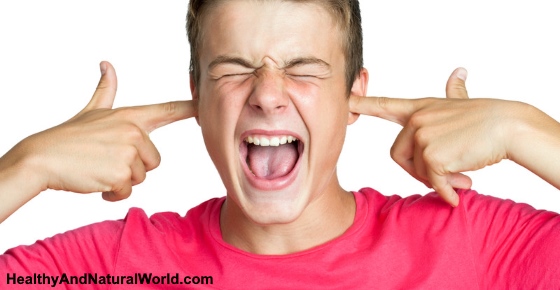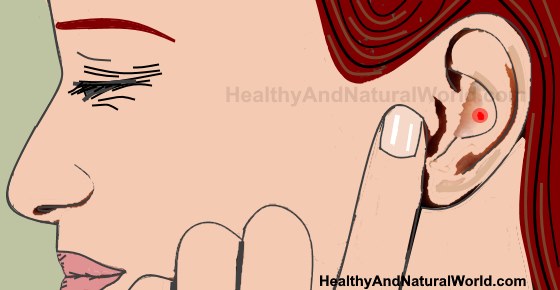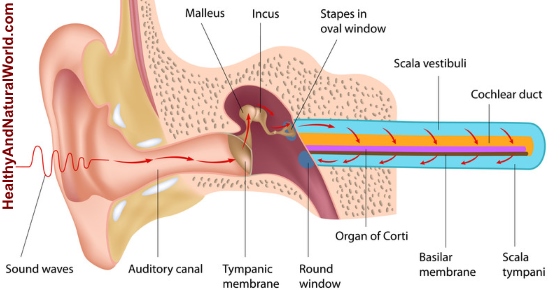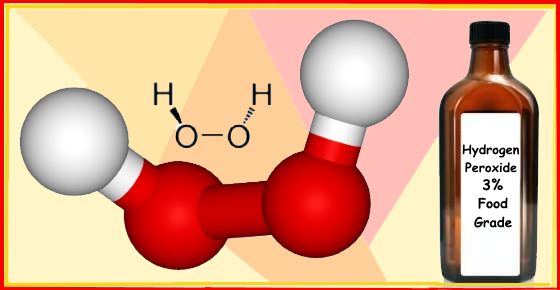What is 35 Percent Food Grade Hydrogen Peroxide?
Food grade hydrogen peroxide that is sold as a 35% solution is a mixture of additive-free hydrogen peroxide and 65% water.
The chemical name of hydrogen peroxide is H2O2 which is a combination of hydrogen and oxygen particles. Hydrogen peroxide is a colorless solution with strong oxidizing properties.
The National Center for Biotechnology Information says that 35% hydrogen peroxide is classed as commercial strength. The reason why it is called food grade is that the H2O2solution doesn’t contain any additives or stabilizers.
The British Dental Journal says that in clinical settings 35% hydrogen peroxide is powerful enough to be used to whiten teeth. However, this is always carried out by a qualified dental technician. There are also reports that using 35% hydrogen peroxide to whiten teeth can cause them to become more sensitive.
It doesn’t matter if hydrogen peroxide is classed as “food grade,” you shouldn’t use 35 percent food grade hydrogen peroxide at home.
What is 3 Percent Hydrogen Peroxide?
3% food grade hydrogen peroxide is sold in many drugstores, supermarkets, and online as an over-the-counter antiseptic solution.
According to the U.S. National Library of Medicine, purified water are added to 3% hydrogen peroxide. You can use 3% hydrogen peroxide to kill off germs and prevent oral infections.
Doctors warn that 3% H2O2 should never be ingested and you shouldn’t use the solution for longer than a week.
However, when used properly, there are many uses for 3% food grade hydrogen peroxide around the home. Some of the uses of hydrogen peroxide include use as an antiseptic mouthwash, surface disinfectant, toothbrush cleanser, and an antibacterial rinse for vegetables.
Here are some of the best uses of hydrogen peroxide.
Hydrogen Peroxide Mouthwash (Gargling with Hydrogen Peroxide)
One of the popular reasons to use food grade 3% hydrogen peroxide is to gargle with diluted hydrogen peroxide.
As with any grade of hydrogen peroxide – 35% hydrogen peroxide, 12% hydrogen peroxide, or 3% hydrogen peroxide – you should be careful not to swallow any of the solution.
Are there any scientific studies backing up the use of hydrogen peroxide as a mouthwash? According to the Australian Dental Journal, using a low concentration of hydrogen peroxide mouthwash over long periods of time is a safe practice. Rinsing your mouth with an H2O2 solution helps to kill off bacteria without damaging teeth or gums.
There is also evidence that 3% food grade hydrogen peroxide can be good for keeping your toothbrush free from germs. One study found that 3 percent hydrogen peroxide was an effective toothbrush disinfectant. In fact, the hydrogen peroxide was more effective than commercially-produced dental products.
When gargling with hydrogen peroxide, it is important to make sure and not swallow any of the solution, even if the food grade hydrogen peroxide solution is less than 3%.
Doctors in 2017 reported on a case of a woman complaining about gastritis and colitis which was the result of swallowing 3% hydrogen peroxide. Although a 3% H2O2solution is generally regarded as nontoxic, doctors advise against ingesting it.
Let’s look at some ways you can safely use 3% hydrogen peroxide to keep your mouth free from germs and bacteria.
How to rinse your mouth with hydrogen peroxide
You can easily make a hydrogen peroxide gargle at home to help kill off germs from your mouth.
To safely gargle with hydrogen peroxide you will need to start with a bottle of food grade 3% hydrogen peroxide. You should be able to find this in your local drugstore. This is how to gargle with the peroxide mouthwash:
- Dilute 1-part 3% hydrogen peroxide with 2-parts water. This will give you a low concentration of 1% hydrogen peroxide.
- Take a small mouthful of the hydrogen peroxide mouthwash, and swish around your mouth for 60 seconds. Then spit out.
Gargling with hydrogen peroxide can help whiten teeth
You may find that regularly using a low concentration of hydrogen peroxide (less than 3%) will result in having whiter, brighter teeth.
Research from 2014 on the teeth-whitening effect of 1.5% hydrogen peroxide found that it can act as a bleaching agent on teeth. The research found that the hydrogen peroxide solution lightened teeth. The solution was used for 4 minutes a day for 28 days.
One study from 2015 found that the best results from using hydrogen peroxide to whiten teeth is to use the solution over a few months. Researchers found that hydrogen peroxide helps to break down darkened molecules that can cause teeth to lose their white color.
You can combine baking soda and hydrogen peroxide to whiten your teeth. See detailed instructions in this article.
Gargling with hydrogen peroxide helps to cure a sore throat
Because hydrogen peroxide even at 3% concentrations has an antibacterial effect, gargling with hydrogen peroxide can also help cure a sore throat.
You should make your hydrogen peroxide gargle for a sore throat with a 1% hydrogen peroxide solution. For this, you should mix 1 part of 3% food hydrogen peroxide (H2O2) and 2 parts of water. Gargle for up to 60 seconds, taking care not to swallow any of the solution.
If you have trouble gargling or you have young children who have a sore throat, you should use a salt gargle instead. This will prevent any irritation to your esophagus by inadvertently swallowing the peroxide solution.
Here are the instructions to make your own saline gargle to break up mucus in your throat and help kill off throat infections.
- Dissolve ½ to 1 teaspoon of salt in an 8-oz. glass of warm water.
- Gargle the salt solution 3 or 4 times a day to help soothe the pain and irritation at the back of your mouth.
For added effect, you could add a teaspoon of turmeric to help the infection clear quicker.
Gargling with hydrogen peroxide keeps your mouth free of bacteria
Using a hydrogen peroxide mouthwash to gargle can be part of your daily dental routine to keep your breath fresh and mouth free from bacteria.
Dentists say that good oral health requires reducing levels of harmful bacteria in your mouth. Bacteria can lead to the buildup of plaque and is one of the leading causes of gum disease.
The International Journal of Dental Hygiene published the results of studies on using hydrogen peroxide mouthwashes. A systematic review of over 220 medical articles found that rinsing your mouth with hydrogen peroxide helps to reduce plaque and prevent gingivitis (gum disease).
Other Uses of Food Grade 3% Hydrogen Peroxide
Bleach Alternative to Whiten Clothes
Food grade hydrogen peroxide can act like bleach, which makes it a perfect alternative to keep your clothes white.
Clothes tend to wear out faster when using bleach, however low concentration of hydrogen peroxide won’t do that and it doesn’t leave the bad odor that bleach does. Just add one cup of hydrogen peroxide into a washer load of whites. You can also find more natural bleach alternatives in my previous article.
Stain Remover for Clothes
You can use hydrogen peroxide to remove stains from your clothes or carpet if used fairly soon. (
21) But watch out, hydrogen peroxide can bleach out the fabric as mentioned above, so dab it on an invisible test spot first to see what happens.
Pour 3% food grade hydrogen peroxide directly on the spot to remove stains. Let it set and bubble for 1-2 minutes, rub and rinse with cold water and soap before throwing them in the washing machine. Repeat if necessary.
Surface Cleaner
Hydrogen peroxide can be used in many ways in your kitchen and at home to remove stains and kill germs.
A study from 2016 mentions that hydrogen peroxide-based liquid surface disinfectants are effective alternatives to disinfectants currently in widespread use in hospitals.
These products were also used as spray to reduce pathogens that cause contamination on soft surfaces such as bedside curtains in hospitals.
You can use hydrogen peroxide at home to clean kitchen counters, floor cleaning (including grout cleaning), table top cleaner, disinfect the inside of your fridge, as well as cleaning your windows.
Just add the 3% food grade hydrogen peroxide into a spray bottle. Spray on the target surface and wipe off, just as a normal household cleaner.
If you want to sanitize, leave the hydrogen peroxide for a longer period before rinsing it off.
You can also find here how to make sanitizing natural household cleaner using essential oils.
3% Hydrogen Peroxide Fights Mold and Mildew in Your Bathroom
Food grade hydrogen peroxide is very effective against mold and mildew. For example a study from 2011 found that hydrogen peroxide mist was effective in decontaminating air in rooms infested with mold after water damage. In another study, hydrogen peroxide was used to reduce the occurrence of mold on food packaging to improve sterilization.
In a similar way as in the kitchen cleaner, add 3% hydrogen peroxide to a spraying bottle and apply directly to the problem areas to remove mold and mildew. Let it set for a few minutes to kill the germs, mold and mildew and wipe them up for a clean and fresh smelling bathroom.
Use Food Grade Hydrogen Peroxide to Remove Pesticides From Fruits and Vegetables
Hydrogen peroxide is also used to remove pesticides and reduce their concentration.
To remove bacteria and pesticides from your fruit or vegetables, add ¼ cup 3% food grade hydrogen peroxide to a full sink and soak the produce for 20 to 30 minutes. Rinse each piece with cold tap water and dry. If you don’t have the time to wait, spray your fruit or veggies with a 3% food-grade peroxide solution, let stand for a few minutes, rinse and dry.
Remove Earwax with Hydrogen Peroxide
Food grade hydrogen peroxide is an effective home remedy for ear wax removal. Hydrogen peroxide drops work by releasing oxygen to soften and remove ear wax and also have a weak antibacterial effect.
If you suffer from a painful or irritating wax build-up, you can use an eye dropper to put 2 drops of hydrogen peroxide into the ear to soften the earwax. Let it set for a minute or so and then use a syringe and carefully flush out with warm water and dry your ear.
Food grade hydrogen peroxide is also one of the home remedies for getting rid of ear infection.
Treat Toenail Fungus, Warts and Skin Tags
Food grade hydrogen peroxide can treat toenail fungus, warts and skin tags.
To treat toenail fungus soak toes or fingers in a 50/50 solution of 3% food grade hydrogen peroxide and water every day and the fungus will be history in no time. Also read my article about natural cure for toenail fungus.
If you suffer from warts or skin tags you can use over-the-counter products to treat warts, or visit a dermatologist that can perform wart or skin tag treatment and removal techniques, but you can also treat these two with hydrogen peroxide. You can find all the details and instructions in the article how to remove skin tags and warts with hydrogen peroxide.
Hair Lightening
Hydrogen peroxide is not only used to bleach clothing, it can be used to lighten your hair as well.
Again dilute 3% hydrogen peroxide with water (50/50) and spray it on wet hair and comb it through to lighten your hair gradually and without the use of harsh chemicals. Just be aware that high concentration of hydrogen peroxide and longer time of bleach treatment may cause hair damage.
Improve Root System of Plants
Hydrogen peroxides adds more oxygen to the soil, which allows plants to take up more nutrients and water to boost the plant’s growth and encourages the development of a healthy and strong root system.
It also kills harmful bacteria and fungus presented in the soil. Just mix 2 teaspoons of 35% food grade peroxide in 1 gallon of water to water your plants. Or use a 3% solution to spray your plants.
Home Remedy for Bacterial Vaginosis (BV)
Food grade hydrogen peroxide (3%) can help to eliminate bacterial vaginosis. It helps to eliminate the bad bacteria by causing it to oxidize. According to doctors, there are no bacteria or fungi that can develop resistance to hydrogen peroxide.
A study published in the Journal of the Medical Association of Thailand found that hydrogen peroxide was able to cure just over 60% of women who had bacterial vaginosis.
You can mix equal parts of water with 3% hydrogen peroxide. Either soak a tampon in the liquid and insert in your vagina for 20-30 minutes or use a douche to help treat bacterial vaginosis and reduce itching. For more information please read the article about the best home remedies for bacterial vaginosis.
Get Rid of Cold Sores (fever blisters) Using 3% Hydrogen Peroxide
Hydrogen Peroxide is a powerful antibacterial and antiviral compound which can help kill the virus that causes fever blisters.
In a study published in the
American Journal of Infection Control, hydrogen peroxide was shown to be able to kill the HSV1 virus that causes fever blisters. (
31)
To heal a fever blister you can add a few drops of 3% food grade hydrogen peroxide to a cotton swab and gently wipe it over the affected area. This may sting a little, but this is the natural astringent properties of hydrogen peroxide which are helping to kill the infection. Repeat this 2 to 3 times a day until your fever blister has disappeared completely.
Home Remedy for the Removal of Red Moles (Cherry Angiomas)
Hydrogen peroxide may be helpful in removing cherry angiomas (red moles). Hydrogen peroxide can be used to help get rid of skin tags and warts naturally because it is a natural bleaching agent. But before using it, make sure to visit your doctor to have the mole checked.
For more information, read the article on how to get rid of red moles on skin.
Medical Uses for 35 Percent Hydrogen Peroxide
Although you can use 3% hydrogen peroxide around the home and to improve your dental health, some websites promote the use of 35% food grade hydrogen peroxide.
Among some of the unsupported claims of using higher concentrations of H2O2 are getting rid of nail and foot fungus, treating ear infections, and eliminating skin mites.
However, as mentioned previously, you shouldn’t use 35% food grade hydrogen peroxide at home.
Can Hydrogen Peroxide Cure Cancer?
Is there any truth to the claims that hydrogen peroxide can be used as a cure for cancer?
Some websites claim that hydrogen peroxide is an alternative cancer treatment because it contains oxygen. It is claimed that cancer cells thrive in low oxygen environments and oxygenating tumors helps to kill off cancer cells. This was based on research carried out in the 1930s by Otto Heinrich Warburg.
Because of this theory, some people claim that you can drink or inject 35% hydrogen peroxide solutions to cure cancer.
Does modern scientific research backup claims that hydrogen peroxide cures cancer?
There are no recent scientific studies that show you can use hydrogen peroxide in any solution to treat cancer.
In fact, studies point to the fact that hydrogen peroxide therapy (called oxymedicine) is probably non-effective in cancer treatment. There is even evidence that hydrogen peroxide could promote the spread of cancer.
The journal Cell Cycle in 2011 found that cancer cells actually produce their own hydrogen peroxide. Scientists discovered that applying hydrogen peroxide to cancer cells can actually help to “feed” them and promote their spread (metastasis). They also found that hydrogen peroxide could also cause cell damage and result in the development of tumors.
Information published by the American Cancer Society in 1992 reported on the results of a number of scientific studies. Their conclusion was that there is no evidence that oxymedicine is effective for treating any chronic disease, let alone cancer.
There are also other serious health implications of self-administering food grade 35 percent hydrogen peroxide. The U.S. Food and Drug Administration (FDA) warns that ingesting 35% hydrogen peroxide can cause serious harm or death. It is also illegal to promote 35% H2O2 therapy as a cure for cancer, AIDS, or any other chronic illness.
Hydrogen Peroxide on the Skin – Is it Safe?
Hydrogen peroxide 3% is generally regarded as safe to use and has many uses around the home and in healthcare.
According to the National Capital Poison Center, 3% food grade hydrogen peroxide can be irritating to the eyes and skin. (
14) However, many people claim that putting 3% hydrogen peroxide on wounds can help to heal them quicker.
But should you put hydrogen peroxide on your skin to prevent infections and help wounds heal faster?
Some studies indicate that doctors can use 3% hydrogen peroxide to help treat wounds. However, hydrogen peroxide is often used as a solution with other ingredients and used in a clinical setting.
When it comes to treating wounds at home, doctors generally advise against using household 3% hydrogen peroxide due to its irritant nature. The Mayo Clinic advises not to use hydrogen peroxide to rinse wounds.
In fact, there are many reasons not to put hydrogen peroxide on your skin to heal wounds. Apart from the 3% solution irritating your wound even further, doctors from WebMD warn that hydrogen peroxide could damage wound tissue even more.
To clean a wound and prevent infection, doctors recommend washing the damaged skin with plenty of soap and water and then covering with sterile gauze.
So, in short, you should avoid putting food grade 3% hydrogen peroxide on your skin to remove germs or clean wounds.
The Dangers of Exposure to Food Grade Hydrogen Peroxide
Food grade hydrogen peroxide, even in concentrations as low as 3%, can cause some irritation to your skin, eyes, airways (if you breathe it in), or esophagus (if you swallow it).
The Journal of Toxicology reports that ingesting 3% hydrogen peroxide can cause irritation to the gastric lining. There have even been reports of long-term ingestion of hydrogen peroxide causing gastric ulcers.
You should also remember that 3% hydrogen peroxide can cause a lot of foam when it comes into contact with the skin. It could even cause a lot of foaming at the mouth if it is ingested. However, this is usually a benign chemical reaction and is usually nothing to worry about.
Generally, swallowing 3% household hydrogen peroxide causes gastric upset, vomiting, and mouth irritation. If this happens, you should drink some milk or water to help dilute the solution.
Consuming large amounts of food grade hydrogen peroxide can result in more serious gastric upset and even burn the stomach lining. This requires emergency medical attention.
Exposure to 35% food grade hydrogen peroxide is more serious and can even be fatal. Ingesting strong food grade hydrogen peroxide can result in serious injury to the gastric lining and gas formation in the veins. This type of exposure can cause a stroke, ulcers, and life-threatening reactions.





